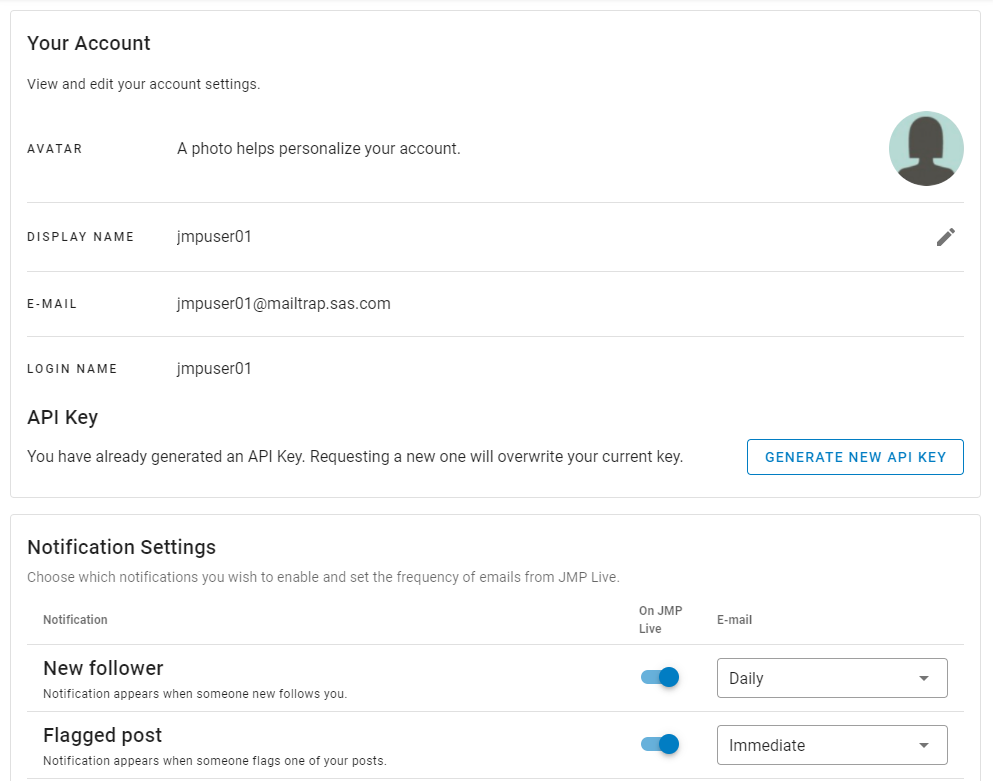JMP Public Help
Create visualizations with your data in JMP and share your analyses as posts in JMP Public. Anyone viewing these posts has the interactive capabilities of JMP to explore your data.
Find out more about these JMP Public topics:
Register for JMP Public
If you are not signed in to JMP Public, you see only featured posts. Before you can publish posts, you need to register and sign in.
|
1.
|
In a browser, go to https://public.jmp.com.
|
Supported browsers include Chrome, Firefox, Safari, and Edge (based on Chromium).
|
2.
|
At the top right, click Sign in.
|
|
3.
|
If you already have a SAS profile, log on using those credentials, then click Submit.
|
|
4.
|
If you do not have a SAS profile:
|
|
a.
|
Click Create profile. Complete the form and click Create profile.
|
|
b.
|
Follow the instructions in the email to set your password and activate your profile.
|
|
5.
|
(Optional) To change your profile name or picture once you are signed in to JMP Public, see Edit Your Profile or Account.
|
Publish JMP Graphs and Reports
Create your graphs and reports in JMP and publish them as a JMP Public post. Posts can be private or shared with everyone or a group. If you publish several reports at once, they appear in a folder.
For details about how to publish your graphs and reports from JMP, see Publish Reports to JMP Public in the JMP Help.
Figure 1.1 JMP Public Thumbnails (Grid View)
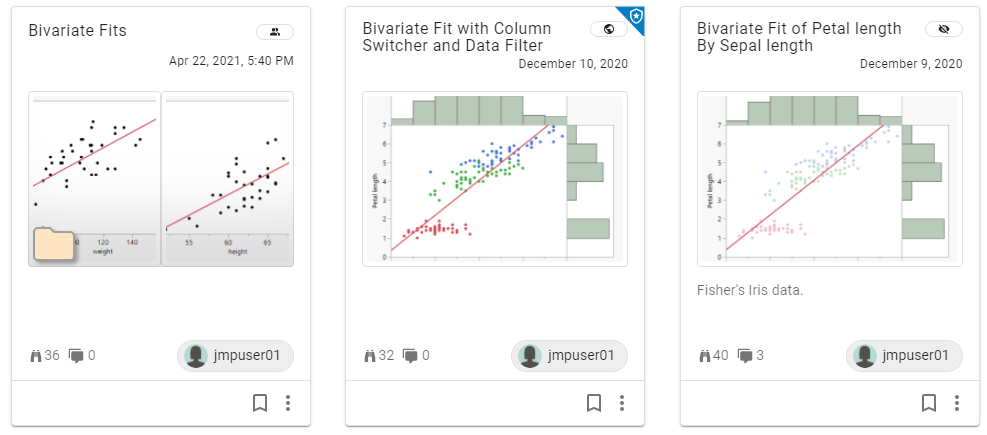
In the thumbnails, you can see the post’s title, the last time the post was updated, a thumbnail image, a description (if available), and the post’s author. Icons on thumbnails show the following information:
|
|
The post is private; only you (and administrators) can see it
|
|
|
The post is shared with everyone
|
|
|
The post is shared with groups
|
|
|
The public post has been featured by an administrator
|
|
|
The post is a folder and can contain several reports
|
|
|
How many views the post has
|
|
|
How many user comments the post has
|
|
|
You have not bookmarked the post
|
|
|
You have bookmarked the post
|
Figure 1.2 Example of a JMP Public Post
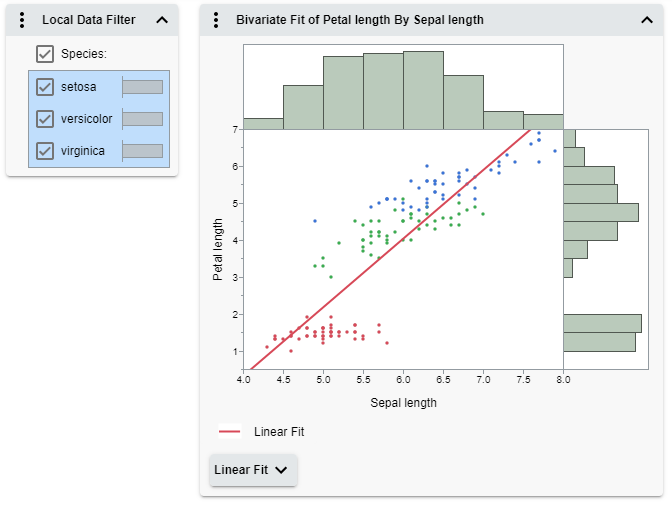
Interact with Posts
Find out what you can do to JMP Public posts:
Open Posts
Tip: To navigate in JMP Public using a keyboard, use the Tab and Enter keys.
|
1.
|
Click an option under Home or click Featured:
|
|
–
|
My Dashboard contains your posts, posts of people that you follow, and posts in groups that you belong to.
|
|
–
|
Bookmarks contains posts that you have bookmarked.
|
|
–
|
All Posts contains all posts from your dashboard and all public posts (shared with everyone).
|
|
–
|
Featured contains any posts that are featured by a JMP Public administrator.
|
Figure 1.3 Home Options

|
2.
|
Click a post to open it.
|
A single post opens directly. If there are several posts, a folder opens and you can click the post that you want to see.
Tip: In a folder, use the navigation icons to move between posts.
|
3.
|
(Optional) To see detailed information about a post, click Details
|
Figure 1.4 Open the Details Pane from a Thumbnail
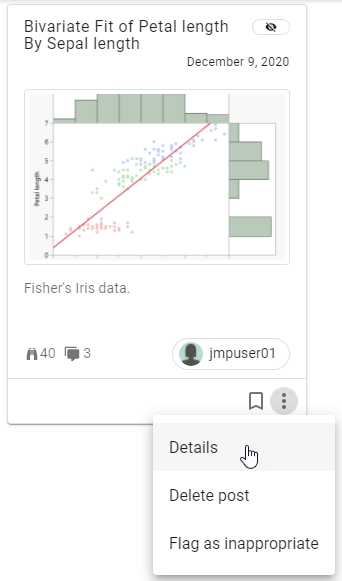
Update Posts
In the Details pane, you can update posts that you own.
|
1.
|
In your post, click Details
|
|
2.
|
Next to the section that you want to update, click Edit
|
You can update the title, thumbnail image, description, sharing settings, and more.
Tip: In the post description, you can use these HTML tags: <a href= "target">, <b>, <em>, <i>, <strong>, and <u>.
Figure 1.5 Update a Post’s Details
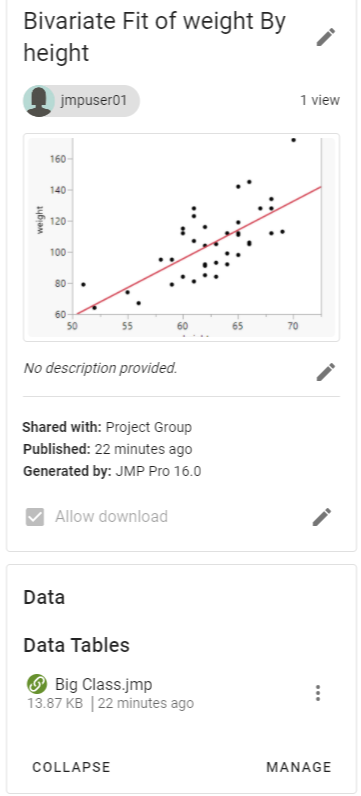
Related Information
Share Posts
When you publish a JMP report, you choose how you want to share it. You can keep the post private, share it with everyone, or share it with specific groups (the post appears on both the group page and on the members’ Home pages). You can also change the sharing settings on a post or folder that you own in JMP Public.
Change the sharing settings on a post
|
1.
|
In your post, click Details
|
|
2.
|
Next to Shared with, click Edit
|
|
3.
|
Select an option.
|
Tip: To stop sharing a post, set the option to Only Me. You can also quickly stop sharing a post with groups from a thumbnail by clicking  > Stop sharing with groups.
> Stop sharing with groups.
|
4.
|
Click Save.
|
Share posts on social media or with a link
In your post, click Share  or if you do not see the Share icon, click More
or if you do not see the Share icon, click More  > Share > Copy link.
> Share > Copy link.
You can share a post in any of these ways:
|
•
|
On social media, such as Facebook, Twitter, LinkedIn
|
|
•
|
Email or copy a link
|
|
•
|
Copy embedded HTML code (for a web page)
|
Figure 1.6 Sharing Options
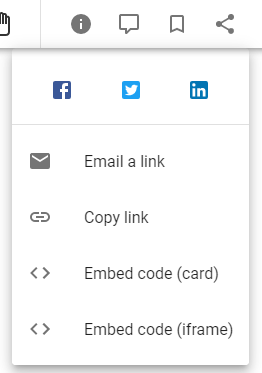
Tip: If you are sharing your own post, and it is private (only you can see it), you will not see all of these options. You must first share your post with everyone to see these options.
Comment on Posts
Tip: You can see how many user comments are on a post in the thumbnail next to the Comments icon  .
.
To see or add comments to a post or folder:
|
1.
|
In a post or folder, click
|
Any existing comments appear.
Note: In addition to user comments, you might also see system comments, which are mainly informative. System comments are not included in the comment count.
|
2.
|
In the Write your comment here box, enter a comment. To respond to an existing comment, click Reply and enter a comment.
|
Tip: You can use basic HTML, such as bold (<b> or <strong>), italics (<i> or <em>), preformatted (<pre>), or underline (<u>). You can also use markdown, such as headings (#, ##, etc.), bold (**text**), and italics (*text*).
|
3.
|
Click Submit.
|
|
4.
|
(Optional) To edit or delete your comments, click More
|
Assuming that you do not turn off these notifications, you get a notification in these situations:
|
•
|
If someone adds or replies to a comment on a post that you own
|
|
•
|
If someone replies to a comment that you made
|
|
•
|
If someone deletes a comment that you made
|
Bookmark Posts
If you want to quickly access a post or a folder, you can bookmark it in JMP Public.
In a post or folder, click Bookmark  or click More
or click More  > Bookmark. To see all your bookmarked posts and folders, at the top, click Home > Bookmarks.
> Bookmark. To see all your bookmarked posts and folders, at the top, click Home > Bookmarks.
Figure 1.7 Bookmarks Page
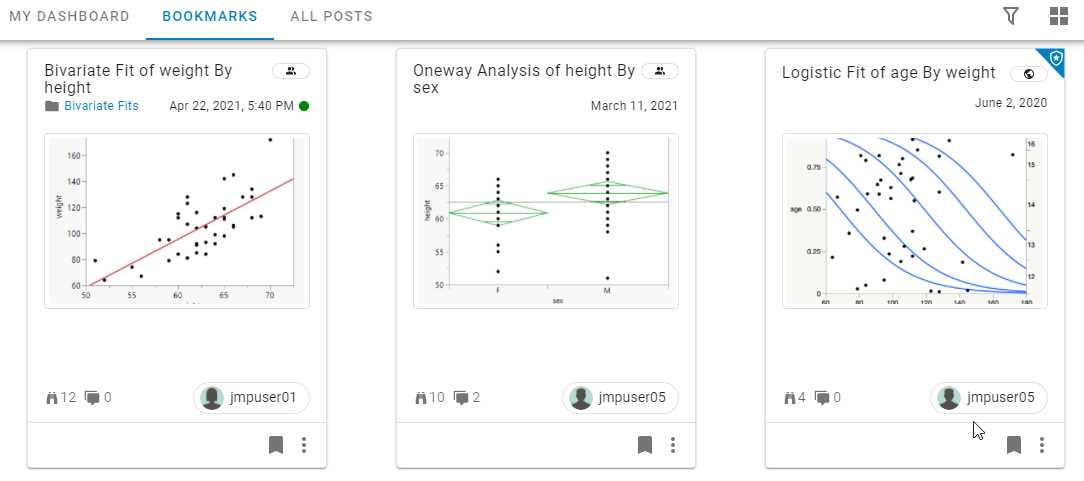
If a post is in a folder, a folder link appears below the title.
Updated posts have a green dot next to their time stamp. After you view the post, the green dot disappears.
To remove a bookmark, click Unbookmark  or click More
or click More  > Unbookmark.
> Unbookmark.
Move Posts
You can move your JMP Public posts into a folder that you own.
|
1.
|
At the top right, click your user icon > My Profile.
|
|
2.
|
Under Posts, hover over a post and click the check mark. Repeat for any other posts you want to move.
|
|
3.
|
Next to Move to folder, click the arrow and select a folder.
|
|
4.
|
Click Move to folder
|
Remove a post from a folder
|
1.
|
In a folder, hover over a post and click the check mark. Repeat for any other posts you want to remove.
|
|
2.
|
Click Remove from folder
|
The posts are now stand-alone.
Delete Posts
To delete a single post or a folder that you own, from a post, folder, or thumbnail, click More  > Delete post.
> Delete post.
Figure 1.8 Delete a Post
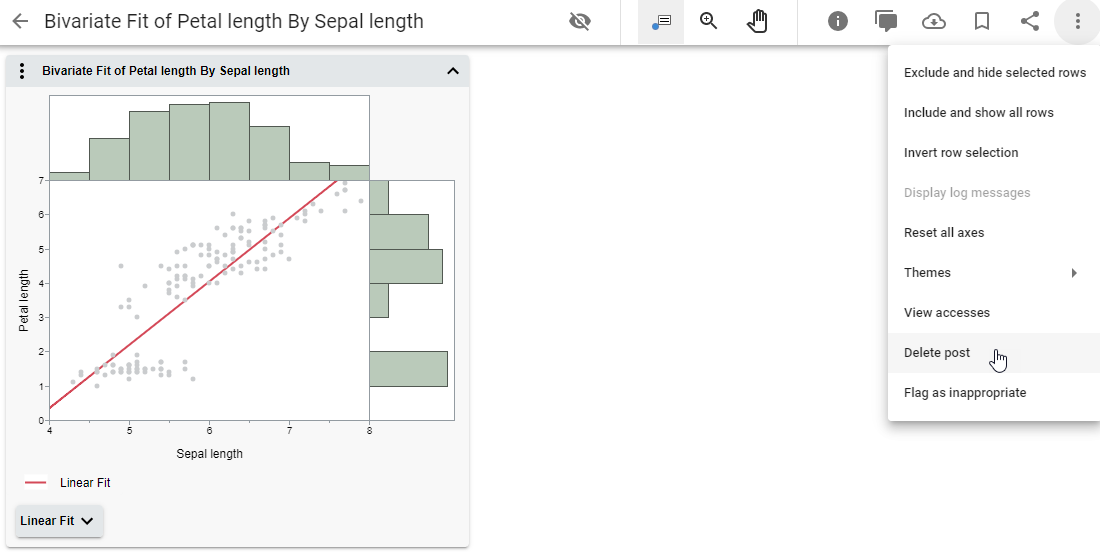
Delete several posts or folders
|
1.
|
At the top right, click your user icon > My Profile. Or, if the posts you want to delete are in a folder, open the folder.
|
|
2.
|
Hover over a post and click the check mark. Repeat for any other posts you want to delete.
|
|
3.
|
Click Delete selected posts
|
|
4.
|
Click Confirm.
|
Manage Notifications on Posts
Notification Types
In JMP Public, depending on your notification settings, you might be notified when these things happen:
|
•
|
someone new starts following you
|
|
•
|
someone adds or replies to a comment on one of your posts
|
|
•
|
someone replies to or deletes a comment that you made
|
|
•
|
a request that you made to join a group is approved or denied, or you are added or removed from a group
|
|
•
|
someone requests to join a closed group that you are an administrator of
|
|
•
|
someone flags a post that you created or flags your user profile
|
|
•
|
an administrator deletes one of your posts, or a folder that includes one of your posts, or if one of your posts is removed from a group
|
Open or act on notifications
To see your notifications, click Notifications  . From here, you can perform the following actions:
. From here, you can perform the following actions:
|
•
|
To open the source, such as a post, click a notification.
|
|
•
|
To clear a notification, click More
|
|
•
|
To stop receiving notifications of a certain type, click More
|
|
•
|
To mark all notifications read, click Mark All as Read
|
|
•
|
To remove all notifications, click Clear All
|
|
•
|
To manage notifications, click Settings
|
|
•
|
To see all notifications in a larger window, click See All.
|
Change Notification Settings
On the Notification Settings page, you can choose which types of notifications you want to receive and how often you want to get email notifications.
|
•
|
Stop receiving a notification: Under On JMP Public, click the switch to off (dimmed).
|
|
•
|
Change how often you get email notifications: Under E-mail, choose a frequency.
|
|
•
|
To sort notifications by ascending or descending order, click the arrow next to Notification.
|
Figure 1.9 Example of Notification Settings
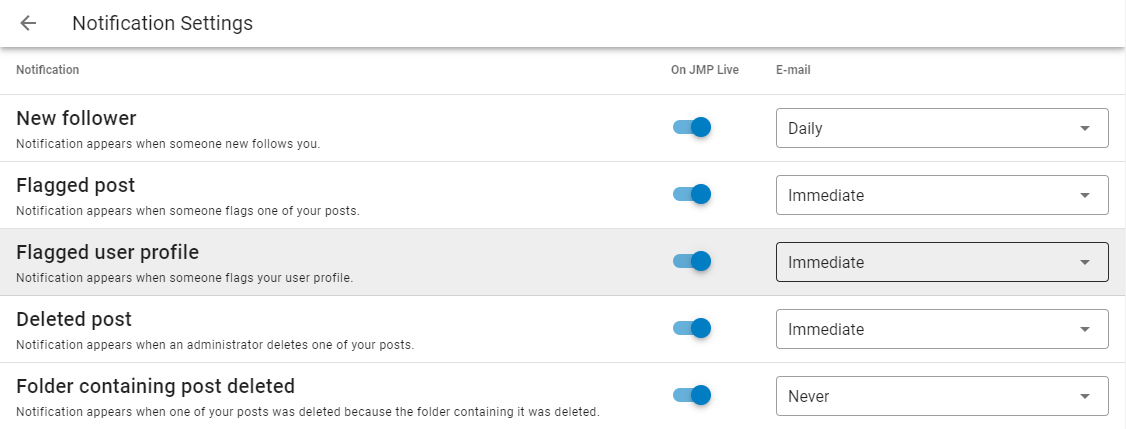
Download Posts as JMP Projects
If you want to open a post in JMP, download the post and any related content as a JMP project file. The project file keeps all of the post content in one tabbed window in JMP. Content associated with a post can include data tables, scripts, maps, or images.
Note the following:
|
•
|
You must have permission to view the post or folder and permission to download any associated data and scripts.
|
|
•
|
Static reports are not saved to the project file.
|
Download a post or folder as a JMP project
|
•
|
From a single post or folder, click Download as JMP Project
|
For details about projects, see Work with Projects in the JMP Help.
See Post Accesses
To see who has accessed a single post or a folder that you own, from a post or folder, click More  > View accesses.
> View accesses.
For a single post or folder, you can see the following details:
|
•
|
who has accessed the post or folder
|
|
•
|
whether the person viewed the post or folder or downloaded data
|
|
•
|
when the person accessed the post or folder
|
Flag Posts or Users
If you think a post or user profile contains inappropriate content, you can flag it to the administrator:
|
1.
|
Do one of the following actions:
|
|
–
|
To flag a post: On a thumbnail or from a post, click More
|
|
–
|
To flag a user profile: From a user profile, click More
|
|
2.
|
(Optional) Add comments to explain the issue.
|
|
3.
|
Click Submit.
|
Here is what happens when a post or user profile is flagged:
|
1.
|
JMP Public administrators determine whether a flagged post should be cleared (the flag removed), hidden, or removed, and whether a flagged user profile should be cleared or hidden.
|
|
2.
|
If the administrator hides or removes a flagged post, or hides a flagged user profile, the owner of the post or the flagged user is notified (if they have not turned off notifications for flags). For hidden posts or users, the owner or user can attempt to fix the problem and let the administrator know. The administrator can then reinstate the post or user if they approve.
|
Change the Theme in Posts
To temporarily change the page appearance while you are viewing a post, at the top right, click More  > Themes.
> Themes.
Figure 1.10 Change the Page Theme
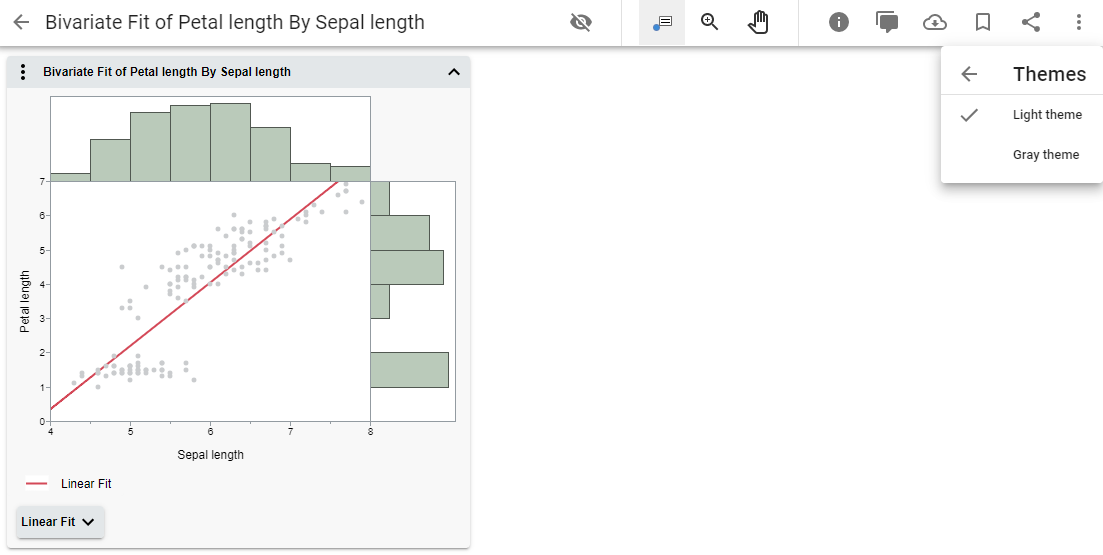
Show Log Messages for Posts
In a post, you can click More  > Display log messages to see error messages from the server, connection messages, and any messages from the client.
> Display log messages to see error messages from the server, connection messages, and any messages from the client.
Change the Layout of Posts
At the top right, click a display icon to change the layout of posts:
|
|
Grid
|
|
|
List
|
|
|
Compact list
|
Find out what you can do with JMP Public data and graphs:
See Data Values or Descriptions
|
1.
|
Click or tap Identify Objects
 . . |
|
2.
|
Hover over or tap a data point or a calculation.
|
Figure 1.11 See a Data Point’s Values
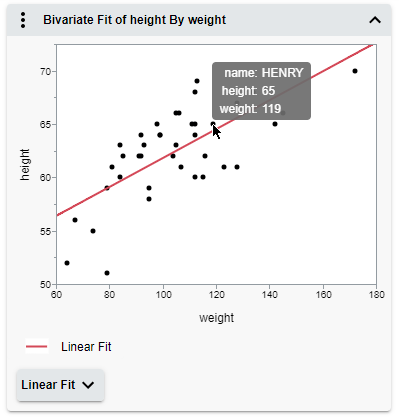
Figure 1.12 See an Explanation of a P-Value Calculation

Tip: To hide or show reports and graphs, at the right of a title, click or tap the arrow.
Select Data and Navigate in Graphs
How you select data in a graph (points, bars, and so on) depends on whether you are on a computer or a mobile device. The default mode is to select a single data point.
|
On a computer
|
On a mobile device
|
|
|---|---|---|
|
Select or deselect a single data point
|
Click a data point.
|
Tap Select One Object
 then tap a data point. then tap a data point. |
|
Select or deselect multiple data points
|
Hold down the Shift key and click multiple data points.
|
Tap Select Multiple Objects
 then tap multiple data points. then tap multiple data points. |
|
Identify a single data point
|
Hover over a single data point.
|
Tap Identify Objects
 then tap a data point. then tap a data point. |
|
Select data points by brushing
|
Click and drag a rectangle over data points. Click and drag in the center to move the rectangle, or drag the corners to resize it.
|
Tap Select Multiple Objects
 then draw a rectangle over the data points. Drag the center to move the rectangle, or drag the corners to resize it. then draw a rectangle over the data points. Drag the center to move the rectangle, or drag the corners to resize it. |
|
Zoom
|
Click Magnifier
To zoom out, double-click in the graph, or press Shift and click in the graph.
You can also use the scroll wheel on your mouse to zoom in and out. If you are not in Zoom mode, press Alt before zooming with the scroll wheel.
|
Tap Magnifier
|
|
Pan in a graph
|
Click Grabber
|
Tap Grabber
|
|
Pan axes
|
Click the middle of an axis and drag.
|
Touch the middle of an axis and drag.
|
|
Scale axes
|
Click at either end of an axis and drag.
|
Touch either end of an axis and drag.
|
|
Return axes or graphs to their original state
|
Press Alt and double-click in the graph, or click More
 or or  > Reset All Axes. > Reset All Axes. |
Double-tap in the graph, or tap More
 > Reset All Axes. > Reset All Axes. |
Note: In interactive HTML, some graphs do not support panning and zooming. Panning and zooming is fully supported in JMP Public.
See Linked Data
If your JMP report contains multiple graphs, data in all graphs are linked. So if you select data, it is highlighted in all associated graphs.
Figure 1.13 Select Data in Linked Graphs
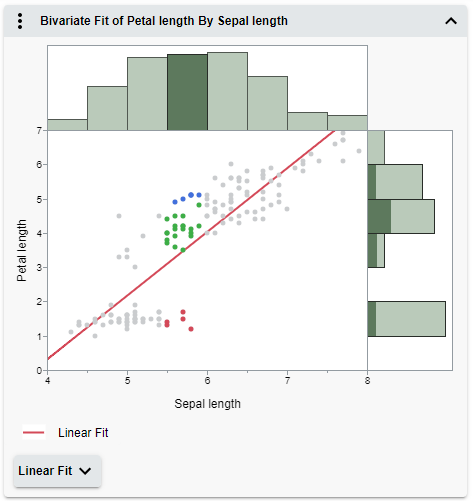
In this example, a histogram bar in the top graph is selected. The corresponding rows are highlighted in the scatterplot and in the marginal histogram.
Exclude and Hide Data
Once you have selected data, you can exclude it from report calculations and hide it in graphs. Reports and graphs automatically update.
Figure 1.14 Report Menu Options
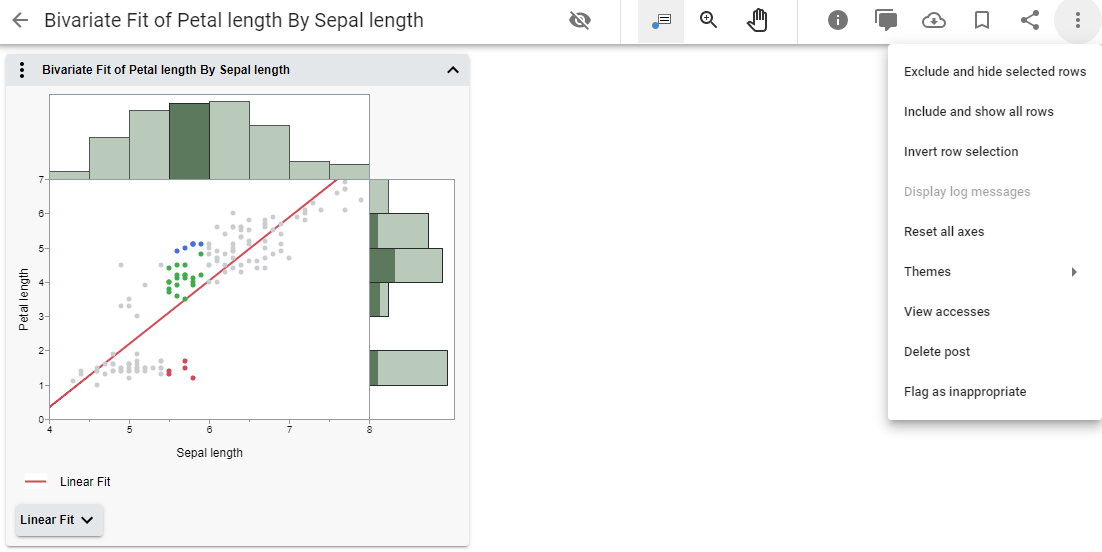
To exclude and hide data, use the options in the More  menu on the right:
menu on the right:
Note: If the report contains a Local Data Filter, most of these options do not appear, since you use the Local Data Filter instead.
|
•
|
Exclude and hide selected rows: Excludes and hides selected data.
|
|
•
|
Include and show all rows: Includes and shows any excluded or hidden data.
|
|
•
|
Invert row selection: Changes the current selection to the deselected data.
|
Filter Data
If the original JMP report included a Local Data Filter, you can use the filter to focus on specific data and see the impact on graphs and reports.
Figure 1.15 Filter Data in Graphs
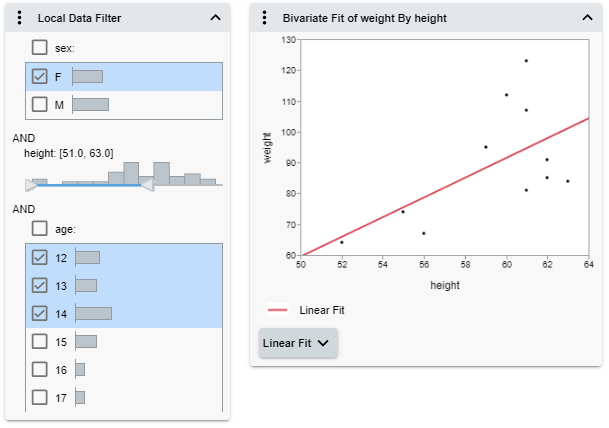
In this example, the filter choices are showing only females between 51 and 63 inches tall who are between the ages of 12 and 14.
Tip: If several categories are selected and you want to select a single category, click the category (not the check box).
Local Data Filter Options
Conditional Filtering
Limits the options in the Local Data Filter by condition. For more information, see Using JMP.
Note: This option does not appear if there is more than one OR group, or if the columns are not hierarchical.
Invert filter
Inverts currently selected filters.
Select filtered rows in graphs
Selects all filtered rows in graphs.
Show filtered rows in graphs
Shows all filtered rows in graphs.
Include filtered rows in calculations
Only filtered rows are included in report calculations.
Update Data
If the data associated with a post changes, you can update the data in JMP Public without republishing the post. The post updates automatically once the data is updated.
JMP Public administrators and the publisher of a post can update data.
|
1.
|
In a post, click Details
|
|
2.
|
Under Data, click Expand to open the pane.
|
|
3.
|
Click Manage.
|
|
4.
|
Click Update Data.
|
|
5.
|
Click in the Select data tables box, or next to a data table, click Update.
|
|
6.
|
Navigate to the updated data table on your computer and click Open.
|
|
7.
|
Click Submit.
|
|
8.
|
(Optional) To undo the update and revert to the previous version, click Undo Last Update, and then click Revert.
|
Delete Data
If a data table is no longer referenced by posts, you can delete it.
|
1.
|
In a post, click Details
|
|
2.
|
Under Data Tables, click More
|
If the data table is still in use by posts, this option is disabled.
|
3.
|
Click Confirm.
|
Share Data in a Folder
A data table in a JMP Live folder can be shared by some or all of the reports in a folder, or each report in the folder can have its own exclusive copy of the data table.
|
•
|
If a data table in a folder is currently shared by two or more reports, you can make it exclusive. Making a data table exclusive creates an individual copy of the data table for each report that was previously sharing one copy.
|
|
•
|
If two or more reports in a folder have exclusive copies of a data table with the same name, you can select a copy of that data table from one of the reports and make that copy shared. The other copies of the data table are deleted, and all of the reports now share that one copy of the data table.
|
Make data shared or exclusive
|
1.
|
In a folder or folder post, click Details
|
|
2.
|
Under Data Tables, click More
|
If you are in a folder and you make a shared data table exclusive, the data table disappears from the folder and is visible only in each individual post.
Switch Data Columns
If the original JMP report included a Column Switcher, you can quickly analyze different variables without re-creating the analysis. When you choose a different variable in JMP Public, the analyses automatically recalculate using the new variable.
In this example, using Fisher’s Iris data, the JMP report includes a Column Switcher and a Local Data Filter.
Figure 1.16 Initial Selections
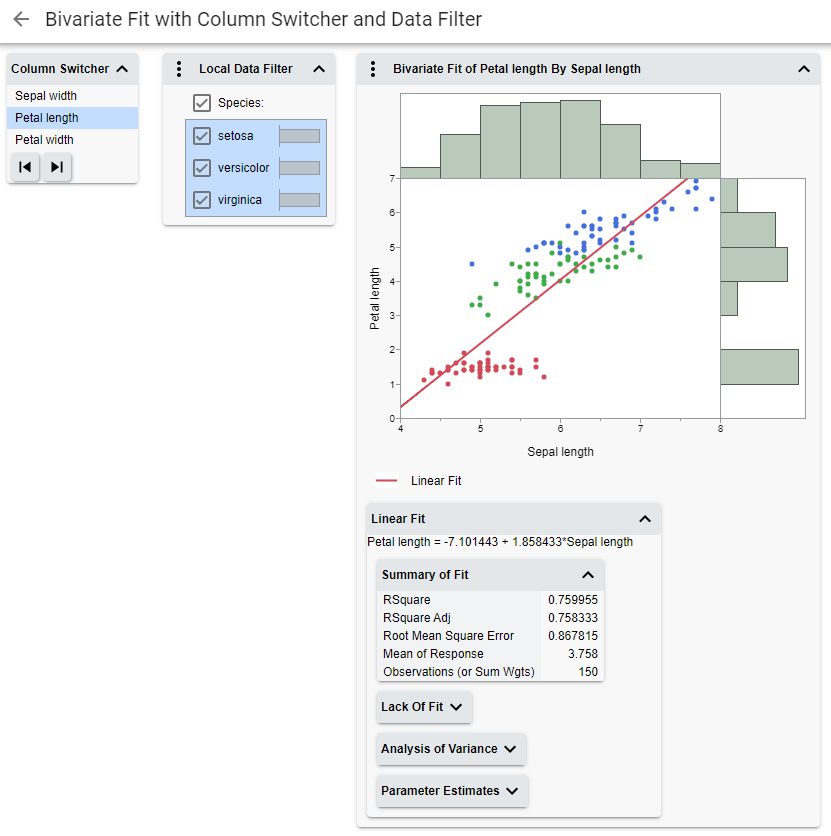
Initially, Petal length (the original column) is selected in the Column Switcher. All species are showing in the Local Data Filter. These selections are reflected in the graph and calculations.
Figure 1.17 Updated Selections
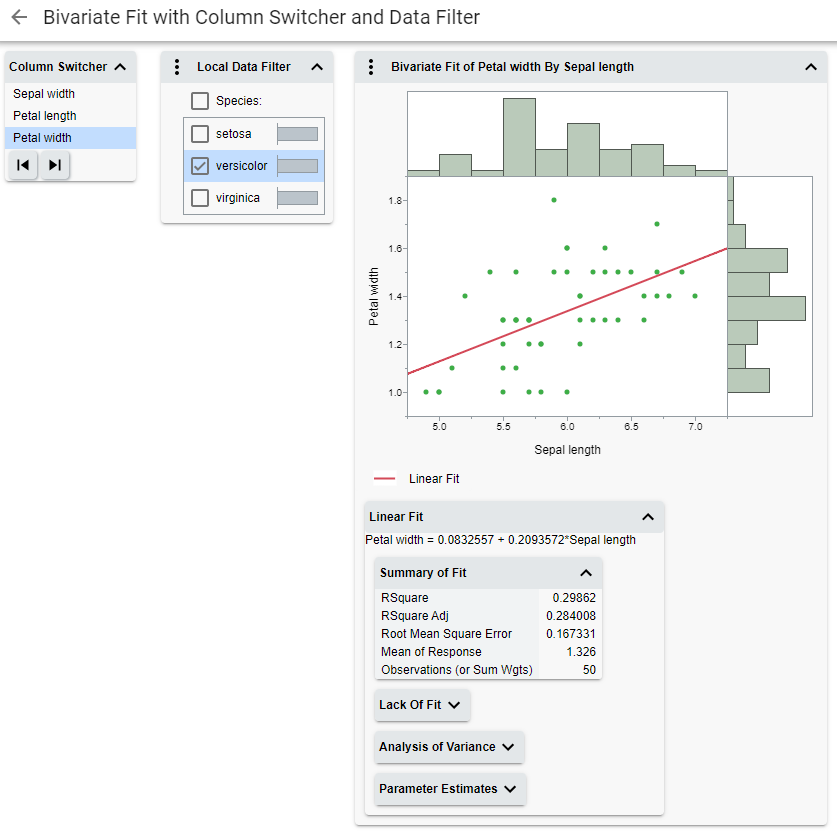
Here, Petal width is selected in the Column Switcher, and only the species versicolor is selected in the Local Data Filter. The graph and calculations update to reflect these selections.
Control Chart Warnings
Posts containing control charts can generate notifications if there are control chart warnings. These people receive notifications:
|
•
|
The publisher of the post
|
|
•
|
Group members the post is shared with (if warnings are enabled for the group). See JMP Public Groups.
|
Depending on individual settings, notifications appear in JMP Public and via email. Email notifications contain more detail about the warnings.
Tip: At an individual level, you can specify which notifications you get and how often. See Manage Notifications on Posts.
When you publish a JMP report that contains a control chart, you can specify whether to enable warnings. You can also enable warnings from a JMP Public post.
Enable or disable warnings
|
1.
|
In a post that contains a control chart, click Details
|
|
2.
|
Under Warnings, click on or off.
|
|
3.
|
(Warnings on only) If the post has active warnings, choose whether to notify people about these warnings.
|
See details about warnings
|
1.
|
In a post or from a thumbnail, click Warnings
|
|
2.
|
Under Warnings, click Expand to open the pane.
|
Figure 1.18 Example of Control Chart Warnings
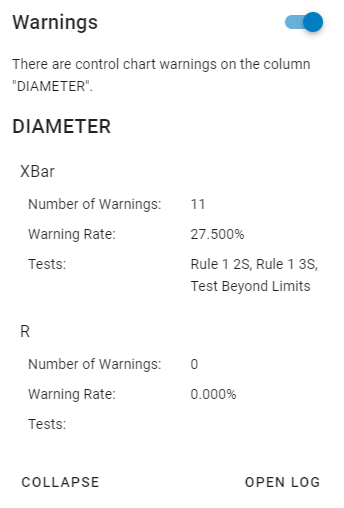
|
3.
|
(Optional) For more detailed information, click Open Log.
|
To copy the log information, click Copy  .
.
Note: If you filter data or change row states (for example, if you exclude or hide rows) control chart warnings are not triggered or updated in JMP Live. Any warnings in JMP Live appear as captured when the data was originally published.
Download Data or Scripts
When you publish a JMP report to JMP Public, you can specify whether to allow users to download the data and script associated with the report. You can also change the download setting from a JMP Public post.
Change the download setting
Note: You can change the download setting from a JMP Public post only if you published the data when you published the JMP report.
|
1.
|
In a post, click Details
|
|
2.
|
Next to Allow download, click Edit
|
|
3.
|
Select or deselect Allow download.
|
|
4.
|
Click Save.
|
Download data or scripts
|
1.
|
In a post, click Details
|
|
2.
|
Under Data or Script, click Download
|
|
3.
|
(Optional) To copy a script, click Copy
|
The Script pane and download options do not appear if the publisher chose not to allow downloading.
Customize Graphs
Note: These customizations are temporary while you are in the post.
Use the options in the More  menu next to a report to customize graph elements.
menu next to a report to customize graph elements.
 menu next to a report to customize graph elements.
menu next to a report to customize graph elements.
Figure 1.19 Change the Marker Size
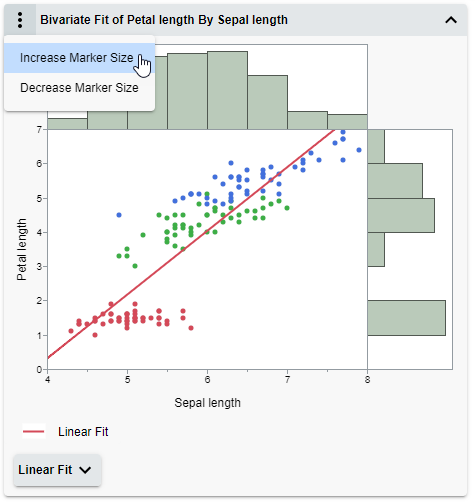
The options in this menu can vary depending on the type of graph or JMP platform. For example:
|
•
|
In scatterplots and histograms, you can change the marker size.
|
|
•
|
In profilers, you can reset the profiler to its original state, or re-scale the vertical axis to include the response.
|
|
•
|
In data filters, you can choose how you want to filter data.
|
|
•
|
In bubble plots, you can change the appearance of the bubbles, add a time label, or change the aggregation method.
|
|
4.
|
|
JMP Public Groups
In JMP Public, only JMP administrators can create groups and add members. However, you can join any open groups and request to join any closed groups.
|
•
|
To see only groups that you have been added to, click Groups > My Groups.
|
|
•
|
To see all groups, click Groups > All Groups.
|
In your groups, you can do the following:
|
•
|
post to the group
|
|
•
|
see all posts and members in the group
|
|
•
|
leave the group
|
Search for Posts, Users, or Groups
To search all of JMP Public, enter a keyword in the search box at top right. Click Posts, Users, or Groups to see specific types of results.
Figure 1.20 Search by Keyword
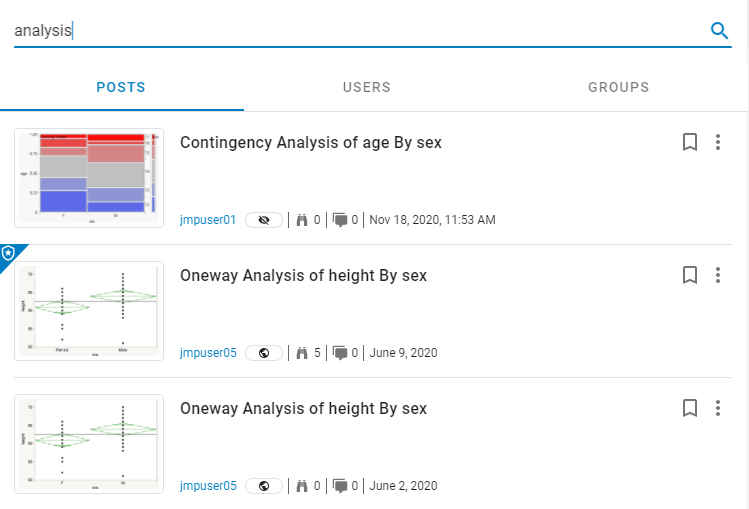
Here are some things that you can do from the search results:
Posts
|
•
|
To open a post, click the title or image.
|
|
•
|
To open the post author’s profile, click their user name.
|
|
•
|
To bookmark a post, click Bookmark
|
|
•
|
To flag a post as inappropriate, click More
|
|
•
|
To delete a post that you own, click More
|
Users
|
•
|
To follow a user, click Follow. If you follow someone, their posts appear on your dashboard.
|
|
•
|
To open a user’s profile, click their user name.
|
Groups
|
•
|
To open a group, click the group name.
|
|
•
|
To join a group, click Join.
|
|
•
|
To leave a group, click More
|
|
•
|
If you are a group administrator, click More
|
|
–
|
Add or manage members
|
|
–
|
Enable or disable warnings on control charts shared with a group
|
|
–
|
Edit a group’s name and description
|
|
–
|
Delete a group
|
|
–
|
You can also click Groups in the top navigation bar and enter a group in Find group.
|
Use Filters
You can use filters to narrow your searches on posts or groups.
Filter Posts
|
1.
|
Click Home and click My Dashboard, Bookmarks, or All Posts, depending on where you want to search.
|
|
2.
|
At the top right, click Filters
|
Figure 1.21 Filter Options on Posts
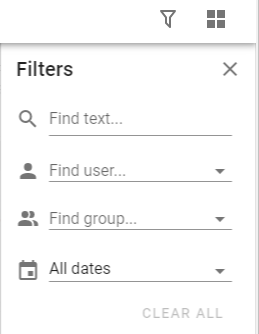
|
3.
|
Enter any combination of keywords, user or group names, or dates.
|
|
4.
|
Click outside of the Filters pane to see the results.
|
|
5.
|
To stop filtering, click Clear Filters.
|
Filter Groups
|
1.
|
Click Groups and click My Groups or All Groups, depending on where you want to search.
|
|
2.
|
At the top right, click Filters
|
Figure 1.22 Filter Options on Groups
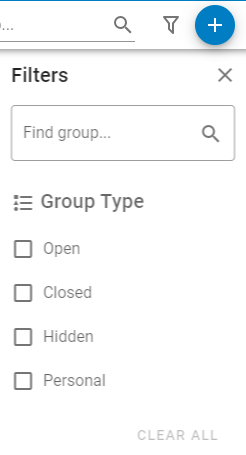
|
3.
|
Enter keywords in the group name. You can also select a group type.
|
|
4.
|
Click outside of the Filters pane to see the results.
|
|
5.
|
To stop filtering, click Clear Filters.
|
Edit Your Profile or Account
Edit your profile
|
1.
|
At the top right, click your user icon > My Profile.
|
|
2.
|
Click your avatar to change it.
|
|
3.
|
Click Edit
|
|
4.
|
Click Save.
|
Change your language
At the top right, click your user icon > Language and select a language.
Verify your account details
|
1.
|
At the top right, click your user icon > Settings.
|
|
2.
|
Verify your login name or the email associated with your account.
|
|
3.
|
(Local authentication method only) Verify or change your password.
|
|
4.
|
Change your notification settings. See Change Notification Settings.
|
Figure 1.23 Edit Your Account Settings
